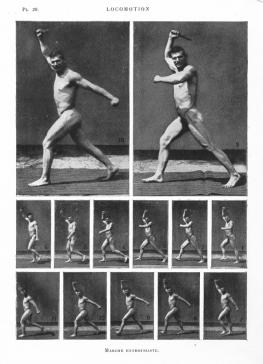Although gestures have been the object of codification within rhetorical traditions since Antiquity, the project to study them scientifically only crystallized in the early nineteenth century. The Science de l’Homme, advocated by a number of “médecins-philosophes,” followed a distinction between “gesture” and “locomotion,” confining the latter to a purely mechanical process, to be studied independently from culture and communication.
Whereas the manifold forms of locomotion were studied experimentally during the late nineteenth century within a special branch of physiology, human gestures had meanwhile become objects of archeological, ethnographic, and linguistic research. Since then, their investigation has been commonly tied to aesthetic, psychological, and sociological interests, and, in more ambitious attempts, led to the formulation of a semiology of social life.
Despite the growing differentiation between a mechanics and a semiotics of techniques of the moving body, one has to note that the anthropology of gestures emerged as a field in which both approaches mingled in unexpected ways. The aim of this project is not only to detail how the epistemological problematic of the seizure of the intangible was tackled within a wide range of research areas, but also to ask what kind of objects gestures constitute for the human sciences.

